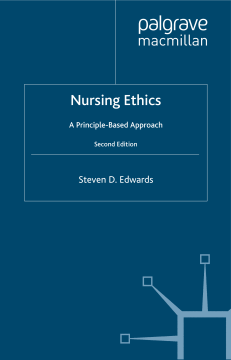
Additional Information
Book Details
Abstract
'…this is one of the clearest and most thorough introductions to theoretical ethics for nurses I have read.' - Dr Simon Woods, Director of Teaching& Learning, Policy Ethics and Life Sciences, University of Newcastle, UK '...I will be recommending this 2nd edition just as I have hitherto recommended the 1st edition.' - Dr Derek Sellman, Principal Lecturer, School of Health and Social Care, University of the West of England, UK
Struggling to understand ethics? Feeling lost when trying to handle moral dilemmas in professional practice? Worried about helping patients to make decisions in an ethical way?
Nursing Ethics is an introductory text which enables you to consider, understand and tackle difficult moral problems. It takes a principle-based approach, which provides a practical and easy-to-apply framework for addressing ethical dilemmas. The book includes clear descriptions of moral theories and concepts and is packed with case examples – giving it immediate relevance to everyday nursing situations.
As well as being significantly revised and updated, this new edition includes discussion of the Nursing and Midwifery Code (2008) and an entire chapter dedicated to genetics and the related complex ethical
issues.
Simple, clear and accessible – Nursing Ethics is an essential purchase for all students and practitioners of nursing and health care.
STEVE D. EDWARDS is Professor at the School of Human and Health Science at Swansea University, UK.
Reviews of 2nd edition draft typescript:
'I would have no hesitation in recommending this book as essential reading for Healthcare Ethics modules.' - Dr Janet Holt, Senior Lecturer, School of Healthcare, University of Leeds, UK
This 2nd edition of the successful text, Nursing Ethics provides readers with a comprehensive grounding in the principle-based approach to resolving moral dilemmas. Fluent and well organized, this fully revised book is core reading for all nursing students and practitioners facing ethical copmplexities in clinical practice.
Table of Contents
| Section Title | Page | Action | Price |
|---|---|---|---|
| Cover | Cover | ||
| Contents | v | ||
| Preface | vii | ||
| Introduction | ix | ||
| 1 Preliminary Matters | 1 | ||
| What is ethics? | 1 | ||
| Why should nurses study ethics? | 6 | ||
| The inherent moral dimension of nursing practice | 9 | ||
| How can moral issues be identified? | 12 | ||
| Conclusion | 17 | ||
| 2 Judgements, Rules, Principles and Theories | 18 | ||
| Moral judgements | 19 | ||
| Moral rules | 20 | ||
| Moral principles | 26 | ||
| Moral theories: utilitarianism, deontology, virtue theory | 29 | ||
| How are the four levels related? | 47 | ||
| Arguments for the priority of moral principles | 49 | ||
| Conclusion | 55 | ||
| 3 The Four Principles: Respect for Autonomy, Beneficence, Non-maleficence and Justice | 56 | ||
| The principle of respect for autonomy | 57 | ||
| The principle of beneficence | 74 | ||
| The principle of non-maleficence | 80 | ||
| The principle of justice | 86 | ||
| Respect for autonomy as the weightiest principle? | 98 | ||
| The principles and the NMC Code (2008) | 101 | ||
| Conclusion | 105 | ||
| 4 Conflicts between the Principles | 106 | ||
| Respect for autonomy in conflict with beneficence and non-maleficence | 106 | ||
| Autonomy in conflict with justice: allocation of scarce resources | 127 | ||
| Conclusion | 146 | ||
| 5 Care-Based Ethics: A Challenge to the Principle-Based Approach? | 147 | ||
| Clouser and Gert's critique | 148 | ||
| A care-based approach: the fist wave | 149 | ||
| The second wave | 169 | ||
| The third wave | 174 | ||
| 'Principles infused with care' approach | 176 | ||
| Conclusion | 180 | ||
| 6 Applying the 'Principles Infused with Care' Approach in the Context of Genetics | 182 | ||
| Case one: Prenatal screening for Down's syndrome | 184 | ||
| Case two: A request to keep genetic information confidential | 196 | ||
| Case three: A decision to have radical surgery on the basis of genetic information | 200 | ||
| Conclusion | 202 | ||
| 7 Supererogatory Actions in the Context of Nursing | 203 | ||
| What are supererogatory acts? | 205 | ||
| To whom do nurses have obligations? | 207 | ||
| Do nurses undertake supererogatory acts? Five nurse case examples | 211 | ||
| Conclusion | 220 | ||
| Appendix: NMC Code of Conduct (2008) | 221 | ||
| Bibliography | 228 | ||
| Index | 237 | ||
| A | 237 | ||
| B | 237 | ||
| C | 237 | ||
| D | 237 | ||
| E | 237 | ||
| F | 238 | ||
| G | 238 | ||
| H | 238 | ||
| J | 238 | ||
| K | 238 | ||
| L | 238 | ||
| M | 238 | ||
| N | 238 | ||
| O | 238 | ||
| P | 238 | ||
| R | 238 | ||
| S | 239 | ||
| T | 239 | ||
| U | 239 | ||
| V | 239 | ||
| W | 239 | ||
| Y | 239 |
